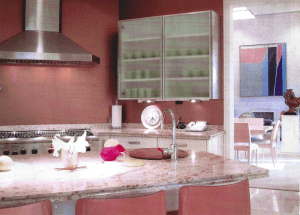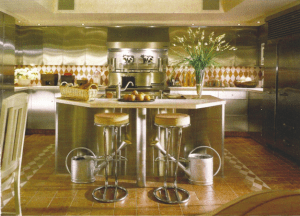A Designer In Every Kitchen
“Eye on Design” Archive from Mann Report (Article By Gail Green)

With the smart homeowner now seeking quality investments that will assure him a valuable return, the renovation of the kitchen is a primary vehicle in which such inflows of money can be reassured a good bet. But because it is one of the two areas of the house or apartment which are the most expensive to renovate per square foot, the functional and aesthetic design of these rooms must be kept at optimum capability. It is not the number of cabinets in the kitchen, but rather their plan and layout that defines the modem kitchen. Great design, quality over quantity, dictates the successful kitchen where a functional use of space combines with style and sense in married partnership.
A great master plan is key in good kitchen design. Once a sound plan is developed and its functional aspects considered, the specification of materials is then made depending on the budget. But no matter how expensive the appliances or tiles specified, the room’s layout must make sense and flow especially in how the spaces interact with each other. So that, while a kitchen for instance may be well laid out functionally, it needs to function well in relation to the surrounding space, whether that space be a dining room, keeping room, den, foyer, hallway, laundry room, etc.
In addition, the modern kitchen is now no longer the providence of mere cooking/preparation center. It encompasses many functional areas: the formal kitchen, the prep center, the wine storage, one or more eating areas (at the kitchen counter with stools and/or a separate table and /or banquette), desk area, media center, or reading area. Here, the whole family can participate in a variety of functions while inhabiting the seamless kitchen.
Nowhere else in the home have there been such revolutionary changes in the types of finishes as in the kitchen. The ‘professional’ look in this type of space has introduced stainless steel as a viable material and is used as appliances, cabinets, countertops, backsplashes, faucets, tiles, banding, and tables. Another great material used innovatively is glass. Glass is now used as cabinets, countertops, floors (tiles), backsplashes, light fixtures, lavatories, and doors in many different varieties: blown, etched, sandblasted, transparent, back painted, mirrored, opaque, colored, and laminated with numerous types of materials in between. Concrete is yet another new material, used especially in the kitchen as countertops and tables and in the bathroom as sinks, tubs, and walls.
Plastic laminates and synthetics (which includes Corian) have finessed the finishing work of their products, so that there is a small price and aesthetic differential between natural and these man-made substances. In the arena of natural materials, limestone takes the lead. Here, floors, countertops, backsplashes in both the tumbled, honed, and polished varieties are predominant. For wall finishes, Venetian stucco is a great material in its ability to be easily cleaned and to have a softened less hi-tech look. Its plaster tint-dyed mixture allows for any color to be painted on the walls. And while it is a rather expensive painting technique, its durability is fantastic.
All of these new advances and materials in kitchen design make these rooms the forerunner for quality investments in the home. Form and function, great style, and usability – those are the catch phrases by which kitchens are now designed. Renovating a kitchen is one of the largest and wisest investments a homeowner can make. So, when deciding to do so, think quality and good design, where less is more.


*Note – Article adapted from print. Images reflect reduced quality.
Click here to view original print article.
____
Like this post?
Subscribe to our newsletter for more design tips, tricks and insights!

